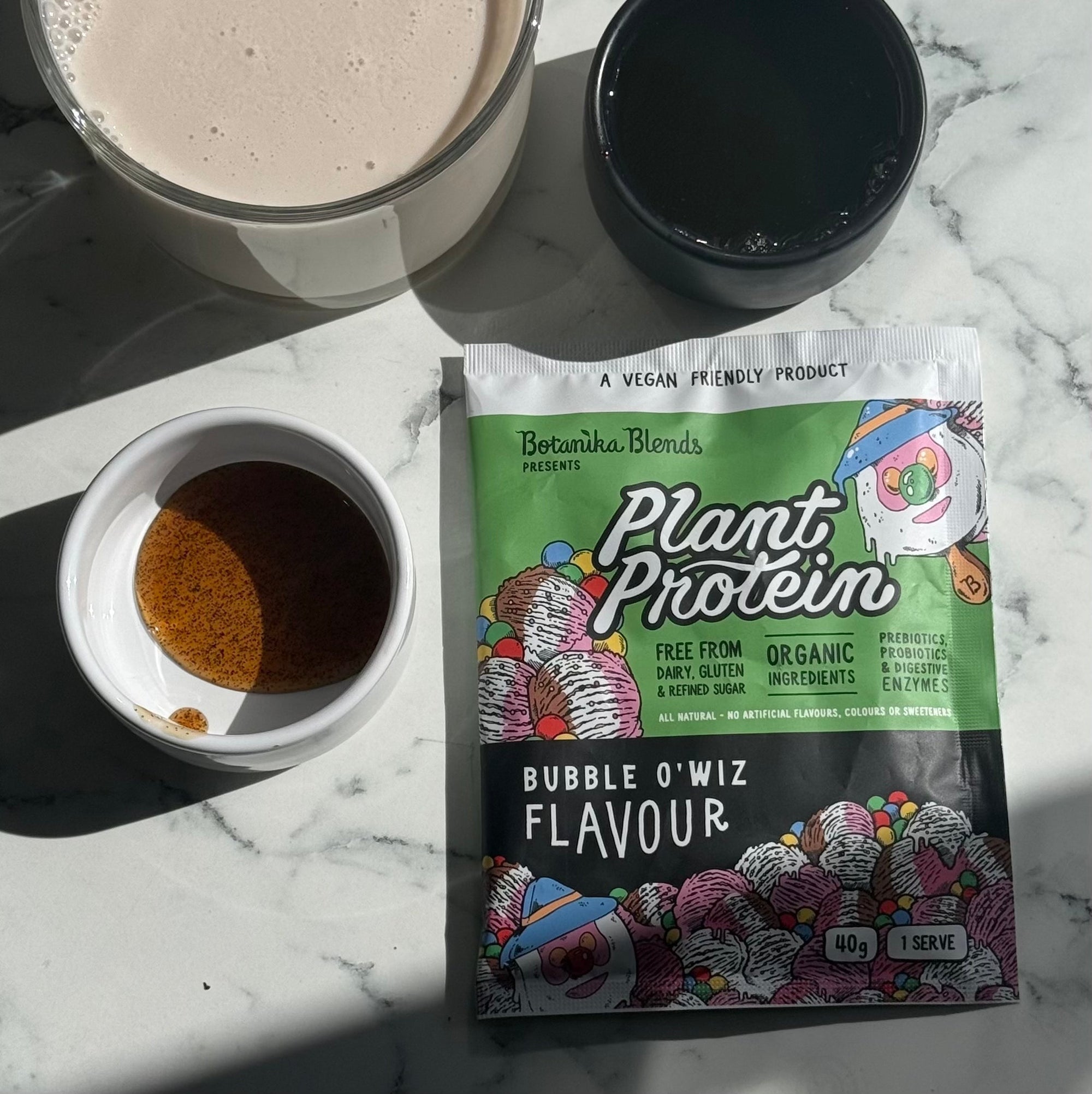

How to Use Protein Shakes: A Complete Beginner’s Guide
Protein shakes have transformed from niche bodybuilding supplements to mainstream nutrition tools used by millions seeking better health, muscle growth, and weight management. Whether you’re new to fitness or looking to optimise your nutrition strategy, understanding how to use protein shakes effectively can significantly impact your results.
Many beginners make costly mistakes when incorporating protein supplements into their routine—consuming too much, choosing the wrong type, or timing their intake poorly. This comprehensive guide will walk you through everything you need to know about using protein shakes safely and effectively, from basic preparation techniques to advanced timing strategies.

👉 Discover our plant protein powders
By the end of this guide, you’ll understand exactly how much protein your body needs, which protein powder suits your goals, when to drink protein shakes for maximum benefit, and how to avoid common pitfalls that can derail your progress.
How to Make and Use Protein Shakes
Creating the perfect protein shake starts with proper preparation and the right equipment. The basic process is straightforward, but small details make a significant difference in taste, texture, and nutritional absorption.
Start with 8-12 oz of liquid as your base. Water provides the lowest calorie option and fastest absorption, while cow’s milk adds extra protein and calories. Plant-based alternatives like almond milk or skim milk offer middle-ground options for those avoiding dairy or managing calories.

👉 Discover our plant protein powders
Add 1-2 scoops (25-50 grams) of your chosen protein powder to the liquid. Most protein powders provide 20-30 grams of protein per scoop, making this range ideal for most individuals’ needs per serving.
Blend or shake vigorously for 30-60 seconds until completely smooth. A quality blender produces the best results, especially when adding whole fruits or vegetables. If using a shaker bottle, ensure it has a mixing ball or wire whisk insert to prevent clumping.
For enhanced nutrition and flavour, consider adding fruits like bananas or berries, 1-2 tablespoons of nut butter for healthy fats, or half a cup of oats for sustained energy and dietary fibre. These additions transform a basic protein shake into a complete meal replacement shake.
Consume your protein shake within 30 minutes of preparation for optimal taste and texture. Protein powders can separate and develop unpleasant textures when left sitting too long.
Pro tip: Always add liquid first, then protein powder. This prevents the powder from sticking to the bottom of your container and creates smoother mixing.
Understanding Your Protein Requirements
Determining your individual protein needs forms the foundation of effective protein supplementation. Your requirements depend on your body weight, activity level, and specific fitness goals.
Sedentary adults need approximately 0.8 grams of protein per kilogram of body weight daily. For a 150-pound (68kg) person, this equals about 55 grams of protein per day. However, this baseline amount only maintains basic bodily functions and may not optimise muscle mass or recovery.
Athletes and individuals focused on building muscle require significantly more protein—between 1.4-2.0 grams per kilogram of body weight daily. A 70kg athlete would need 98-140 grams of protein daily to support muscle protein synthesis and recovery from intense training.
To calculate your specific needs, multiply your weight in kilograms by your activity factor:
-
Sedentary lifestyle: 0.8g per kg
-
Light activity (1-3 days/week): 1.0-1.2g per kg
-
Moderate activity (3-5 days/week): 1.2-1.6g per kg
-
Heavy training (6+ days/week): 1.6-2.0g per kg
Protein shakes become particularly valuable when your total daily protein intake from whole foods falls short of these targets. Many people struggle to consume enough protein through regular meals alone, especially those following plant-based diets or managing busy schedules.
However, prioritise getting most of your daily calories and protein from real food sources. Whole foods provide beneficial nutrients, dietary fiber, and other compounds that protein supplements cannot match. Use protein shakes to bridge the gap between your dietary protein intake and your requirements, not as a primary protein source.
Types of Protein Powder for Shakes
Understanding different protein sources helps you choose the most suitable option for your needs, digestive health, and dietary preferences. Each protein type offers distinct advantages and considerations.

👉 Discover our plant protein powders
Whey Protein Options
Whey protein remains the gold standard for muscle building and recovery due to its complete amino acid profile and rapid absorption rate. Derived from milk during cheese production, whey provides all nine essential amino acids your human body cannot produce naturally.
Whey protein concentrate contains 70-80% protein by weight, with the remainder consisting of carbohydrates and fats. This option offers the most affordable entry point into whey supplementation while maintaining excellent biological value. However, it contains lactose, which may cause digestive issues for sensitive individuals.
Whey protein isolate provides 90% or higher protein content with virtually all lactose and fat removed. This higher purity comes at increased cost but offers faster absorption and eliminates most dairy-related digestive concerns. Whey protein isolate dissolves more easily and produces smoother shakes.
Whey protein hydrolysate represents the most processed form, where proteins are pre-digested into smaller peptides for extremely rapid absorption. While most expensive, this option suits individuals with severe digestive sensitivities or those seeking maximum absorption speed post-workout.
Whey excels for post-workout shakes due to its rapid digestion and high leucine content, which triggers muscle protein synthesis more effectively than other protein sources.
Plant-Based Protein Alternatives
Plant-based protein powders serve vegans, vegetarians, and individuals with dairy allergies while providing excellent muscle-building potential when chosen correctly.

👉 Discover our plant protein powders
Pea protein delivers 20-25 grams of protein per serving with impressive muscle-building capabilities. Research shows pea protein performs comparably to whey for gaining muscle mass when combined with resistance training. It digests easily and rarely causes allergic reactions.
Brown rice protein offers hypoallergenic properties and mild flavour that blends well with other ingredients. While lower in certain amino acids individually, rice protein combines excellently with pea protein to create a complete amino acid profile matching whey’s effectiveness.
Soy protein provides a complete amino acid profile comparable to animal-based proteins. Studies demonstrate soy’s effectiveness for muscle growth while potentially offering additional cardiovascular benefits, including modest reductions in LDL cholesterol levels.
Hemp protein contains omega fatty acids and fiber alongside 15-20 grams of protein per serving. While lower in total protein content, hemp offers additional beneficial nutrients and supports overall gut health through its fiber content.
Many manufacturers now create plant-based protein blends combining multiple sources to ensure complete amino acid profiles while improving taste and texture compared to single-source options.
When to Drink Your Protein Shakes
Strategic timing of protein intake can enhance your results, though the importance of timing varies based on your overall daily protein consumption and specific goals.

👉 Discover our plant protein powders
Post-Workout Timing
Consuming protein shakes within 30-60 minutes after strength training optimises muscle recovery and growth. This post-workout window represents when your muscles are most receptive to amino acids for repair and building processes.
Post-workout protein shakes should contain 25-40 grams of protein to maximally stimulate muscle protein synthesis. Combining your protein with carbohydrates—such as a banana, oats, or even a small amount of added sugars—enhances recovery by replenishing muscle glycogen and improving amino acid uptake.
The rapid absorption of whey protein makes it particularly effective during this timeframe. Your muscles can access amino acids quickly when they’re needed most for recovery processes.
Research shows that consuming protein soon after weight lifting sessions leads to greater muscle mass gains compared to delaying protein intake several hours. However, this effect is most pronounced when your total daily protein intake is borderline adequate.
Alternative Timing Options
Morning consumption provides an excellent way to jumpstart your metabolism and maintain steady energy levels throughout the day. After hours of fasting during sleep, your body benefits from quickly available amino acids to halt muscle protein breakdown.
A morning protein shake works particularly well as part of a complete breakfast or as a convenient meal replacement when time is limited. Adding fruits and healthy fats creates a more balanced nutritional profile for sustained energy.
Between-meal timing helps maintain consistent protein intake throughout the day, supporting continuous muscle protein synthesis. This approach particularly benefits individuals struggling to meet protein requirements through regular meals alone.
Consuming protein shakes between meals can also aid in appetite control and weight management. Protein’s satiating effects help reduce cravings and prevent overeating at subsequent meals.
Pre-workout timing, 30-60 minutes before training, provides readily available amino acids during your workout. While not as critical as post-workout nutrition, pre-workout protein can help prevent muscle protein breakdown during intense training sessions.
Before bed represents an often-overlooked opportunity for muscle recovery optimisation. Slow-digesting proteins like casein provide sustained amino acid release throughout the night, supporting muscle repair during sleep when growth hormone levels peak.
Proper Dosage and Safety Guidelines
Using protein shakes safely requires understanding appropriate dosages and recognizing your individual tolerance levels. While protein is generally safe for healthy people, excessive intake can cause problems.

👉 Discover our plant protein powders
A standard serving of 1-2 scoops (25-50 grams of protein) per shake provides optimal absorption for most individuals. Your body can only utilise approximately 30-40 grams of protein per serving for muscle protein synthesis, making larger doses potentially wasteful.
Research suggests limiting individual protein servings to this range maximises utilisation while minimising digestive stress. Consuming too much protein at once can lead to incomplete absorption and unnecessary caloric intake.
For daily totals, avoid exceeding 2 grams of protein per kilogram of body weight unless under medical supervision. This upper limit prevents potential kidney strain in susceptible individuals while providing more than adequate protein for even the most active athletes.
If you’re new to protein supplements, start with smaller amounts—perhaps one scoop daily—to assess your digestive tolerance. Some individuals experience bloating, gas, or stomach discomfort when beginning supplementation, particularly with dairy-based proteins.
Individuals with kidney disease, liver problems, or other medical conditions should consult healthcare providers before adding protein supplements to their routine. While healthy kidneys handle increased protein loads efficiently, compromised kidney function may struggle with excessive protein intake.
Watch for signs of digestive distress including persistent bloating, cramping, or changes in bowel movements. These symptoms often indicate lactose intolerance (with whey products) or simply consuming too much too quickly.
Pregnant and nursing women should discuss protein supplementation with their healthcare providers to ensure appropriate intake levels that support both maternal and fetal health without exceeding safe limits.
Tips for Better Taste and Mixing
Creating delicious, smooth protein shakes requires attention to ingredient selection, preparation techniques, and flavour enhancement strategies. Poor-tasting shakes often lead to abandoned supplementation routines.
Flavour Enhancement Ideas
Natural ingredients provide the best flavour improvements without artificial sweeteners or excessive added sugars. Frozen berries—particularly strawberries and blueberries—add natural sweetness, vitamins, and antioxidants while creating a thick, smoothie-like texture.
Adding 1-2 tablespoons of natural peanut or almond butter introduces healthy fats and rich flavour while increasing the shake’s satiety factor. These additions also slow protein absorption slightly, providing more sustained amino acid release.
Incorporating half a cup of rolled oats transforms your protein shake into a more complete meal while adding fiber, B vitamins, and sustained energy. Oats blend surprisingly well and create a satisfying, thick consistency.
Unsweetened cocoa powder delivers rich chocolate flavour without added sugars, while also providing antioxidants and minerals. Start with 1-2 tablespoons and adjust to taste preferences.
Surprisingly, adding a handful of spinach or kale provides vitamins and minerals without significantly affecting taste, especially when combined with fruits. The mild flavour gets masked by stronger ingredients while boosting nutritional density.
Cinnamon, vanilla extract, or mint can dramatically improve flavour profiles with minimal caloric impact. These natural flavourings work particularly well with plant-based protein powders that may have earthier base flavours.
Mixing and Preparation Tips
Proper mixing technique prevents the lumpy, chalky texture that ruins many protein shakes. Always add your liquid base first, followed by protein powder. This sequence prevents powder from sticking to container bottoms and ensures more complete mixing.
Using ice cubes creates a thicker, more refreshing texture while helping break up any remaining powder clumps during blending. Ice also slows consumption, allowing better appetite satisfaction.
For smoothest results, blend for 60-90 seconds rather than the minimum time. This extended mixing thoroughly incorporates all ingredients and creates restaurant-quality smoothness.

👉 Discover our plant protein powders
When using a shaker bottle, allow the protein powder to sit in liquid for 2-3 minutes before shaking. This pre-soaking helps powder begin dissolving and reduces the vigorous shaking required.
Clean your equipment immediately after use to prevent protein buildup that creates persistent odors and becomes increasingly difficult to remove. Rinse with cold water first, then wash with warm, soapy water.
Consider investing in a high-quality blender if you plan to consume protein shakes regularly. The improved texture and ability to incorporate whole ingredients justifies the investment for serious users.
Common Mistakes to Avoid
Understanding frequent beginner errors helps you establish effective supplementation habits from the start while avoiding potential setbacks and wasted money.
Many newcomers over-rely on protein shakes instead of prioritising whole food protein sources. While convenient, shakes should supplement—not replace—a healthy diet rich in lean meats, fish, eggs, legumes, and dairy products. Whole foods provide fiber, vitamins, minerals, and other beneficial compounds that isolated protein cannot match.
Consuming excessive protein amounts represents another common error. More protein doesn’t automatically equal better results, and exceeding your body’s utilisation capacity wastes money while potentially causing digestive issues. Stick to evidence-based dosing recommendations rather than following “more is better” mentality.
Ignoring total daily calorie intake when adding protein shakes can derail weight management goals. Each shake contains calories that must fit within your daily energy balance. If weight loss is your goal, account for shake calories by reducing intake elsewhere or increasing physical activity.
Choosing protein powders based solely on marketing claims rather than individual needs and ingredient quality leads to poor results and buyer’s remorse. Research ingredients, read third-party reviews, and consider factors like digestibility, amino acid profile, and manufacturing quality over flashy packaging.
Failing to read labels for added sugars, artificial ingredients, or potential allergens can cause unexpected reactions or undermine health goals. Many commercial protein products contain unnecessary additives that may conflict with your dietary preferences or health conditions.
Perhaps most importantly, expecting protein shakes alone to build muscle without proper strength training and adequate rest represents a fundamental misunderstanding. Protein provides building blocks, but muscle growth requires mechanical stimulus from resistance exercise, adequate sleep, and consistent training progression.
Starting with too much too quickly often leads to digestive discomfort that discourages continued use. Begin with smaller servings and gradually increase as your body adapts to higher protein intake.
Finally, purchasing large quantities of unfamiliar protein flavours before testing smaller sizes wastes money and may leave you with unpalatable products you won’t consume consistently.
Conclusion
Learning how to use protein shakes effectively transforms them from simple supplements into powerful tools for achieving your health and fitness goals. The key lies in understanding your individual protein requirements, choosing appropriate protein types, timing consumption strategically, and maintaining proper dosing guidelines.
Remember that protein shakes work best as part of a comprehensive nutrition strategy that prioritises whole foods, adequate hydration, and regular physical activity. Start with basic preparations using 25-30 grams of protein per shake, consume them at strategic times around your workouts or throughout the day, and gradually adjust based on your body’s response and goal progression.
Whether you’re building muscle, losing weight, or simply trying to meet daily protein targets more conveniently, the principles outlined in this guide provide a solid foundation for success. Begin with simple recipes, focus on consistency over perfection, and don’t hesitate to consult with healthcare providers or nutrition professionals for personalised guidance.
Take action today by calculating your protein needs, selecting an appropriate protein powder, and preparing your first properly mixed shake. Your future self will thank you for establishing these healthy habits now.
Share:
FAQ – How to Use Protein Shakes: A Complete Beginner’s Guide
More blogs
-

Better-For-You Caramel Bars (Vegan Friendly)
Move over, Twix, these vegan caramel bars are here to steal the (snack) spotlight. No refined sugar, no dairy, and absolutely no boring allowed. These better-for-you bars layer a soft, shortbread-style base with a gooey caramel centre (infused with our...
-

Choc & Raspberry Protein Bars (Vegan Friendly)
No bake. No blender. No bull. Just ridiculously easy, high-protein deliciousness. We get it, sometimes you want a snack that feels like dessert but acts like a nutritional overachiever. Enter: these Vegan Choc & Raspberry Protein Bars. They’re crunchy, chocolatey,...
-

10 Tips for Effective Exercise Recovery
Training hard is only half the story—recovery is where real progress happens. Whether you’re lifting weights, running hills, or smashing HIIT, giving your body time to heal and rebuild is essential for muscle growth, performance, and injury prevention. Here are...















